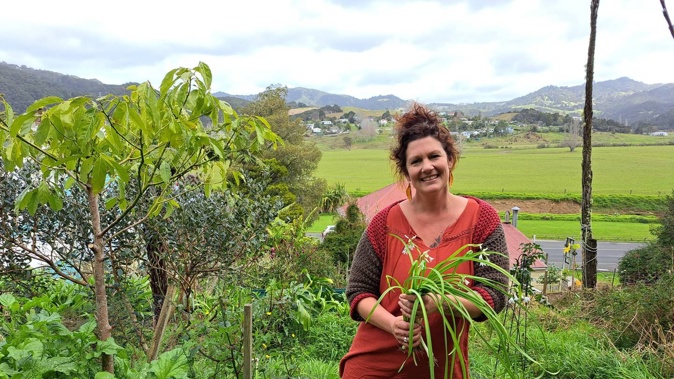
Far North cookbook author, teacher and avid forager Anna Valentine has a world of edible plants and flowers right on her doorstep.
When the mum-of-two wants to create a meal for her family, she simply pops outside to her wild, unkempt garden and gathers what she needs.
Even from the back porch of Valentine’s house in Kāeo, you can see loads of edible plants, including nasturtiums which are packed with flavour and vitamins and minerals.
There’s also wild mustard growing under the washing line that she adds to dip for its mustard flavour, and once the plant goes to seed she collects the seeds for cooking.
Magnolia petals can be pickled or dipped in egg whites and sugar and eaten as candied petals on top of a cake, she said.
Even pansies and violas can be eaten in salads and fresh rice rolls, or placed on top of biscuits and cakes.
There are so many ways to add wild foods to your diet and make the most of your garden or surroundings, according to Valentine.
Not only are they versatile, many edible flowers and weeds have high nutritional value and are also medicinal. They also play an important role in the home garden for attracting bees and other beneficial insects.
“Plants feed your body and feed your soul as well,” Valentine said.
“The wildflowers and leaves have way more nutrition and medicinal value.
“It’s liberating to be able to go in your yard and eat and to teach the kids.
“My girls can go into the garden and pick whatever I ask them for.”
/cloudfront-ap-southeast-2.images.arcpublishing.com/nzme/YRTEHCVN5NDJLM2G4LL3D5KJLY.JPG)
Valentine is so passionate about healthy plant-based food, that she’s had 81 edible plants tattooed diagonally over her body, from her ankle, through her torso to her opposite wrist.
She got the artwork done for her 40th birthday a couple of years ago.
But her love of foraging began much earlier when she and her family moved to Kaeo more than 10 years ago.
“Because I’ve left the garden wild, I discovered the whole property was covered in onion weeds.
“When the yard erupted in onion weed one year, it was like a gateway to foraging.
“I thought ‘we’ve got food here all the time’, so I let the garden do its thing.”
Valentine, a trained chef, also set up The Veggie Tree Cook School and has long been holding cooking workshops in the rustic kitchen of her century-old villa.
She teaches her students vegetarian-inspired recipes and dishes along with basic bread and cheese making, plus preserving and fermentation.
She also runs the Forage and Feast Edible Flowers workshop, where participants learn about edible flowers and weeds, what they taste like, and their benefits.
Students head out into her garden and pick what they need to make edible flower biscuits, flowery spring rice rolls, dips, and tempura onion weed flowers to take home.
She blends camelia petals with salt for a unique look and flavour, and makes use of oxalis – also called wood sorrel - that are tart and sour and make a beautiful garnish.
Dandelion root is good for gut health and is used to detoxify the body: “I eat leaves every day on toast”.
Her favourite is onion weed, which tastes like spring onion or chives, and for which she has loads of recipes on her website.
/cloudfront-ap-southeast-2.images.arcpublishing.com/nzme/DARKWTFW3ZCYNCW7SUNS7RVIPM.JPG)
You can pickle the bulbs and use them as a garlic substitute, use the white flowers as a garnish, or cut the stems for a stir-fry.
“I have onion weeds every day. You can use the leaves like chives ... I have them on scrambled eggs or scrambled tofu.”
Valentine describes her garden as “wild organic and permaculture-ish”.
There are the usual herbs such as mint, sage, lemon balm and rosemary and she has an extensive orchard including apples, olives, macadamias, cherry, mandarins, lemons, limes and plums.
“We let everything do its thing and self-seed where it wants to.
“When I make things with weeds, I use lots of different ones so we get the full range of benefits and balance of the flavours.”
When Valentine can’t find what she wants in her garden, she’ll forage at her favourite spots around the Whangaroa harbour and local beaches.
She’s on the lookout for fat hen, along with samphire and glasswort, also known as “poor man’s asparagus”.
Valentine advises people to get to know their areas and go “well off the road” to avoid picking plants that may have been sprayed by chemicals.
/cloudfront-ap-southeast-2.images.arcpublishing.com/nzme/3RFHE6NT35GKFKTAG7S6WLBFLU.JPG)
It’s also wise to pick plants “away from dog pee height,” she said.
The only plant Valentine can think of which might be unsafe is oxalis, “but you’d need to eat loads of it and you wouldn’t want to eat a lot of it anyway”.
Black nightshade is a “misunderstood” plant, she said.
“Everyone thinks it’s deadly but it isn’t.
“You can eat leaves and berries, they’re high in antioxidants and are used in some countries for lung health.”
Valentine suggests people introduce plants and herbs to their diets slowly, for instance, put a few edible flower petals into a salad or make a salt.
“You don’t have to eat as much wild foods as conventionally grown produce because the benefits and medicinal properties are all higher because it’s had to struggle a bit to grow.
“You can add little bits at a time.”
Valentine is currently working on a cookbook with the working title , which follows Abundance, The Veggie Tree Spring and Summer Cookbook, and The Veggie Tree Autumn and Winter Cookbook.
Anna Valentine’s top 5 edible plants
Onion weed: Super versatile, and you can eat the whole plant all year. Try onion weed fritters, and use them in salads.
Nasturtium: Eat flowers, stems, and leaves. Use in salads, infused vinegar, and as a garnish.
Dandelion: Eat leaves, roots and flowers. Can promote liver health and fight inflammation.
Kelp: Eat raw, cooked, or make into a salt. For iodine, minerals and trace elements.
Kawakawa: Use leaves. Herbaceous, peppery flavour that’s amazing for tea and the digestive and immune systems.
Jenny Ling is a news reporter and features writer for the Northern Advocate. She has a special interest in covering roading, health, business and animal welfare issues.
Take your Radio, Podcasts and Music with you









